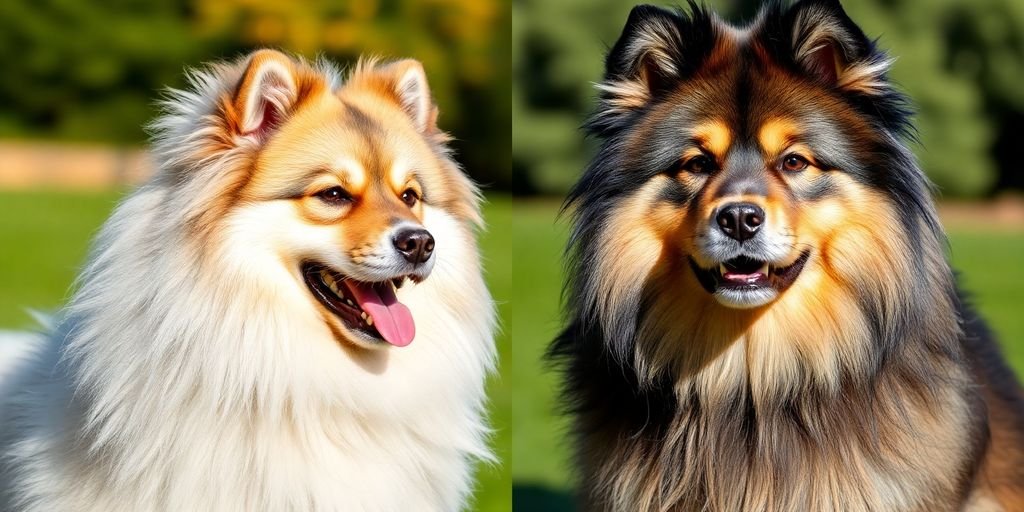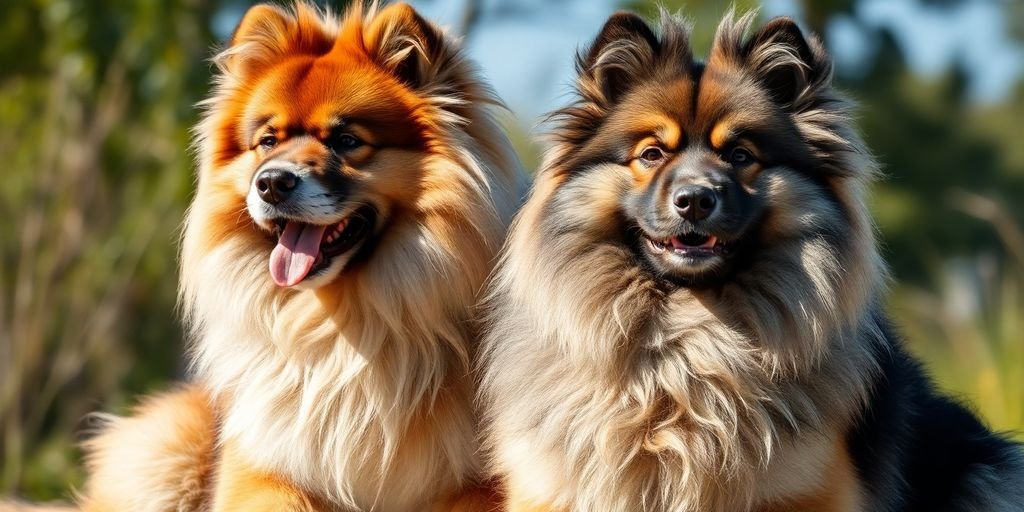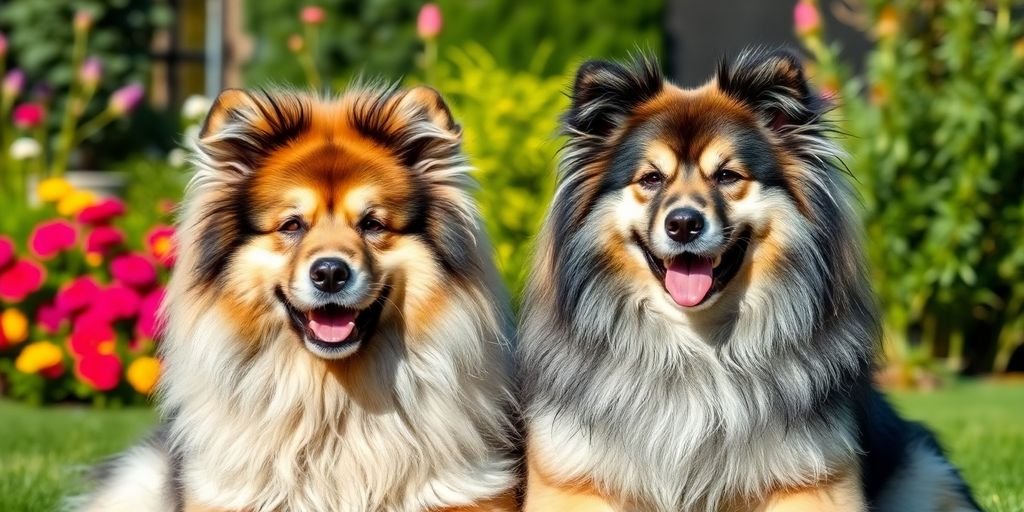
So you’re thinking about getting a new furry friend and can’t decide between a Keeshond and a Eurasier? Both breeds have their unique charms, but they also have differences that might make one more suitable for your lifestyle. Whether it’s their origins, physical traits, or temperament, there’s a lot to consider. Let’s dive into what sets these two apart and see which might be the better fit for you.
Key Takeaways
- Keeshonds hail from the Netherlands and have a long history, while Eurasiers originated in Germany in the 1960s.
- Keeshonds are generally smaller and lighter compared to the larger Eurasier.
- Both breeds are known for being friendly, but Keeshonds tend to be more outgoing with strangers.
- Eurasiers are rare and more expensive, while Keeshonds are easier to find and more affordable.
- Both breeds are intelligent, but Keeshonds might have a slight edge in trainability.
Origins and History of Keeshond and Eurasier
Historical Background of Keeshond
The Keeshond, often known as the “Smiling Dutchman,” has a rich history that traces back to the Netherlands. Originating around the 1400s, these dogs were primarily used as watchdogs on riverboats and barges, hence the nickname Dutch Barge Dog. Their cheerful disposition and keen alertness made them perfect companions for Dutch sailors. The breed gained political significance during the 18th century as a symbol of the Dutch Patriot movement, led by Kees de Gyselaer, from whom the breed gets its name.
Historical Background of Eurasier
In contrast, the Eurasier is a relatively new breed, coming into existence in the 1960s. Developed in Germany, the Eurasier was created by crossing the Chow Chow, Wolfspitz (Keeshond), and Samoyed to achieve a balanced temperament and striking appearance. This intentional breeding was spearheaded by Julius Wipfel, who aimed to create a breed that combined the best traits of its ancestors. The Eurasier is now recognized for its calm demeanor and strong family bonds.
Development and Evolution of Breeds
Both breeds have evolved significantly over the years. Keeshonds have maintained their role as affectionate companions, thriving in family settings and showing adaptability to various living conditions. Meanwhile, Eurasiers have gained popularity for their unique blend of traits inherited from their parent breeds. Their development focused on promoting a stable and gentle nature, making them ideal for families. The careful breeding of the Eurasier has ensured a dog that is both visually appealing and temperamentally sound.
Physical Characteristics: Keeshond vs Eurasier

Size and Weight Comparison
When comparing the size and weight of the Keeshond and the Eurasier, there are some noticeable differences. Eurasiers are generally larger, with males typically weighing between 50-70 pounds and females around 40-60 pounds. They stand taller too, with males reaching 20-24 inches and females 16-18 inches at the shoulder. In contrast, Keeshonds are medium-sized dogs, with males weighing about 35-45 pounds and standing 17-19 inches tall, while females weigh around 30-40 pounds and stand 16-18 inches tall.
Coat and Color Variations
Both breeds boast beautiful double coats, but their colors and textures offer some diversity. Eurasiers come in a variety of colors including black, tan, red, fawn, sable, and wolf gray, giving them a striking appearance. Keeshonds, often referred to as the “Smiling Dutchman,” typically have a mix of gray, black, and cream, creating a distinctive “spectacles” pattern around their eyes.
Distinctive Physical Features
The Keeshond is known for its expressive face and curled tail that rests on its back, giving it a cheerful appearance. Eurasiers, on the other hand, have a more wolf-like appearance with a broad head and erect ears. Both breeds have a fluffy, dense coat that requires regular grooming to keep them looking their best.
Keeshonds and Eurasiers not only differ in size and color but also in their unique physical traits, making each breed distinct yet equally charming.
Here’s a quick table to summarize their size and weight:
| Breed | Male Weight | Female Weight | Male Height | Female Height |
|---|---|---|---|---|
| Eurasier | 50-70 lbs | 40-60 lbs | 20-24 in | 16-18 in |
| Keeshond | 35-45 lbs | 30-40 lbs | 17-19 in | 16-18 in |
These physical traits not only define their appearance but also influence their suitability for different living environments and care needs.
Temperament and Personality Traits

General Temperament of Keeshond
The Keeshond is known for its friendly and outgoing nature. Often described as the “Dutch Barge Dog,” this breed is incredibly social and thrives in environments where they can interact with people and other pets. Keeshonds are genuinely loyal and affectionate, making them excellent companions for families. They are sensitive to their surroundings, preferring a stable routine and a calm household. Although they are not known for being overly protective, their alertness makes them good watchdogs.
General Temperament of Eurasier
The Eurasier is a calm and loyal breed, recognized for its gentle nature. Unlike the Keeshond, Eurasiers tend to be more reserved and may take time to warm up to strangers. However, once they do, they are incredibly devoted and loving. Eurasiers require moderate social interaction and are generally content with the company of their family members. Their temperament makes them suitable for families looking for a more laid-back companion.
Behavioral Differences
When comparing the two breeds, several key differences in behavior emerge. Keeshonds are more social and thrive in lively environments, while Eurasiers are content with quieter settings. Keeshonds have a lower prey drive and are less likely to roam, making them easier to manage in open spaces. On the other hand, Eurasiers may have a higher impulse to chase, which requires careful supervision during outdoor activities. Both breeds are intelligent and eager to please, but their personalities cater to different lifestyle preferences.
Trainability and Intelligence

Training Ease of Keeshond
Keeshonds are known for being quite easy to train. Their intelligence makes them quick learners, and they often respond well to positive reinforcement techniques. This breed is eager to please, which can make training sessions enjoyable and effective. However, it’s essential to keep training sessions engaging, as they can become bored with repetitive tasks. Their quick learning ability makes them a favorite for families looking for an adaptable companion.
Training Ease of Eurasier
Eurasiers are also relatively easy to train, but they might require a bit more patience compared to Keeshonds. They are intelligent and can learn commands quickly, but they do have an independent streak. Consistent training with positive reinforcement is key to bringing out the best in them. These dogs thrive in environments where training is consistent and loving, making them suitable for owners who enjoy a bit of a challenge.
Intelligence Levels Compared
When it comes to intelligence, the Keeshond tends to rank higher than the Eurasier. Keeshonds are often seen as very smart dogs, capable of learning a wide range of commands and tricks. On the other hand, Eurasiers are considered to have average intelligence but are still able to learn and adapt well with proper training. Both breeds are adaptable and can fit well into families with dynamic lifestyles, showcasing intelligence and trainability that allow them to adjust quickly to new routines. This makes them ideal companions for families with dynamic lifestyles.
Both the Keeshond and Eurasier are intelligent breeds, each with their unique training needs. While the Keeshond may learn faster, the Eurasier’s steady and thoughtful approach to training can be equally rewarding.
Health and Lifespan Considerations

Common Health Issues in Keeshond
Keeshonds are generally healthy dogs, but like any breed, they can be prone to certain health problems. Some of the common issues include hip dysplasia and luxating patella. It’s important to schedule regular vet check-ups to catch any potential problems early. This breed may also experience primary hyperparathyroidism, so monitoring their health is key.
Common Health Issues in Eurasier
Eurasiers, on the other hand, might face more frequent health challenges. They are susceptible to hip dysplasia and kneecap dislocations. Regular veterinary visits are crucial, ideally at least once or twice a year, to keep tabs on their health. Despite these concerns, with proper care, they can lead happy lives.
Lifespan and Longevity
When it comes to lifespan, Keeshonds typically live between 12 to 15 years, while Eurasiers tend to have a slightly shorter lifespan of 12 to 14 years. Both breeds can enjoy long, fulfilling lives with the right care and attention. Ensuring a balanced diet and regular exercise can contribute to their longevity, helping them thrive well into their senior years.
Keeping your dog healthy is not just about addressing issues as they arise, but also about preventive care and regular monitoring. This proactive approach can make a significant difference in their quality of life.
Grooming and Maintenance Needs

Grooming Requirements for Keeshond
Keeshonds are known for their thick, fluffy coats, which means grooming is not something you can skip. Regular grooming is essential to keep their fur looking its best and to avoid matting. Here’s what you need to know:
- Brushing: Aim for at least two to three times a week. Their double coat can get tangled easily if neglected.
- Bathing: These dogs don’t need frequent baths, about every 3-4 weeks is fine, but make sure to use a dog-friendly shampoo.
- Nail Trimming: Like most breeds, their nails should be trimmed regularly to prevent discomfort or injury.
Grooming Requirements for Eurasier
Eurasiers, on the other hand, have a coat that requires moderate grooming. Their grooming routine is a bit less demanding compared to the Keeshond.
- Brushing: Once a week is usually sufficient, but during shedding season, you might want to increase this to a couple of times a week.
- Bathing: Similar to the Keeshond, a bath every 3-4 weeks will keep them clean without stripping their coat of natural oils.
- Nail Care: Regular nail trimming is necessary, just like with any other breed.
Shedding and Coat Care
- Keeshond: These dogs are heavy shedders, especially during spring and fall when they “blow” their coat. Investing in a good quality brush will help manage the shedding.
- Eurasier: They shed moderately, so while you won’t find as much hair around the house as with a Keeshond, you’ll still need to be prepared for some cleanup.
Keeshonds and Eurasiers both have unique grooming needs that reflect their distinct coats. While the Keeshond demands more frequent attention, the Eurasier offers a more relaxed grooming routine, making them a bit easier to maintain for those with a busy schedule.
When considering chef’s knives, it’s crucial to maintain them just like these breeds need regular grooming to stay healthy and look their best. Proper care and maintenance can make a world of difference.
Suitability as Family Pets
Family Compatibility of Keeshond
Keeshonds are often seen as the ideal family dogs. They’re incredibly affectionate and have a knack for getting along with everyone, from toddlers to grandparents. Their friendly demeanor makes them great companions for families. Whether you’re living in a bustling city apartment or a quiet suburban home, Keeshonds adapt well due to their moderate exercise needs and love for indoor play.
Family Compatibility of Eurasier
Eurasiers are known for their calm and gentle nature. They are particularly good with children, showing patience and a protective instinct. While they might be a bit reserved with strangers, this trait often translates into a loyal and close bond with family members. Eurasiers thrive in a stable environment and enjoy being part of family activities, making them excellent family pets.
Interaction with Children and Other Pets
When it comes to interacting with children, both Keeshonds and Eurasiers are quite kid-friendly. Keeshonds, with their playful and lively nature, often become the children’s best friend, joining in on games and adventures. Eurasiers, on the other hand, are more laid-back but equally loving, providing a sense of security around kids.
In terms of other pets, Keeshonds generally get along well with other animals, including cats and dogs. Eurasiers also show a good level of compatibility with other pets, although they might prefer to maintain their personal space, especially around unfamiliar animals. It’s important to introduce them properly to ensure harmonious living.
Choosing between a Keeshond and a Eurasier as a family pet can be tough because both breeds offer unique qualities that can enrich family life. Consider your family’s lifestyle and environment to find the perfect fit.
Price and Availability in the Market

Cost of Owning a Keeshond
Owning a Keeshond can be quite affordable compared to some other breeds. You can typically find Keeshond puppies priced between $800 and $1,000. This makes them a budget-friendly option for families looking for a loyal companion without breaking the bank. However, it’s essential to factor in ongoing costs such as food, grooming, and vet visits.
Cost of Owning an Eurasier
On the other hand, Eurasiers tend to be more expensive. Puppies are usually priced between $2,000 and $2,500. This higher cost can be attributed to their rarity and the meticulous breeding standards maintained by breeders. Prospective owners should be prepared for this initial investment, along with the usual upkeep expenses.
Availability and Breeder Considerations
When it comes to availability, Keeshonds are relatively easy to find. They are frequently available from breeders and often appear in rescue centers. In contrast, Eurasiers are much rarer. You might have to wait or travel further to find a reputable breeder. It’s crucial to research and choose a breeder who prioritizes the health and temperament of their dogs over quick sales.
Choosing between a Keeshond and an Eurasier might come down to budget and availability. While Keeshonds are more accessible and affordable, Eurasiers offer a unique and exclusive companionship that might justify their higher price for some pet enthusiasts.
Conclusion
So, there you have it. The Keeshond and the Eurasier, two breeds with their own unique quirks and charms. Whether you’re drawn to the Keeshond’s friendly, outgoing nature or the Eurasier’s calm and reserved demeanor, both breeds have a lot to offer. They each have their own grooming needs, exercise requirements, and personality traits that might make one a better fit for your lifestyle than the other. At the end of the day, it really comes down to what you’re looking for in a furry friend. Both breeds can make wonderful companions, so it’s all about finding the right match for you and your family. Happy dog hunting!
Frequently Asked Questions
What are the origins of the Keeshond and Eurasier breeds?
The Keeshond comes from the Netherlands and has been around since the 18th century. The Eurasier is a newer breed, developed in Germany in the 1960s.
How do the size and weight of Keeshonds and Eurasiers compare?
Keeshonds are medium-sized dogs, usually weighing between 35 to 45 pounds. Eurasiers are larger, weighing between 40 to 70 pounds.
What are the main differences in their temperaments?
Keeshonds are known for being friendly and outgoing, while Eurasiers are calm and reserved but still friendly with their families.
Are Keeshonds and Eurasiers easy to train?
Both breeds are intelligent and can be trained with patience. Keeshonds might be a bit more eager to please, making training slightly easier.
What kind of grooming do these breeds require?
Keeshonds need regular grooming due to their thick double coats, while Eurasiers also need grooming but may shed less.
Which breed is better for families with children?
Both breeds are good with children. Keeshonds are playful and energetic, while Eurasiers are gentle and patient.

